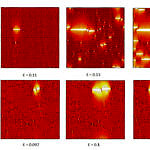HPC User Report from S. Nasiri (Chair for Materials Simulation)
Molecular dynamics simulation of Fracture of Graphene sheet
We use atomistic simulation (molecular mechanics and molecular dynamics) to investigate failure of graphene sheets containing randomly distributed vacancies. We investigate the dependency of the failure stress on defect concentration and sheet size and show that our findings are consistent with the Duxbury-Leath-Beale (DLB) theory of mechanical or electric breakdown in random media.
Motivation and problem definition
Carbon nanoparticles, in particular graphene sheet, have attracted tremendous scientific and technological interest, with applications ranging from nanoelectronics to functional and structural composites . In structural applications, a most attractive feature of graphene is the extreme in-sheet elastic stiffness and rupture strength of perfect sp2 covalently bonded structures. However defects which are unavoidable during the synthesis of graphene-based device could change its mechanical properties dramatically. In this work we aim at identifying the statistical features of strength in graphene sheets containing multiple defects. To this end we conduct an investigation of sheets with randomly distributed vacancies, systematically varying both the sheet size and the vacancy concentration, and determining for each set of parameters the statistical distribution of failure stresses as obtained from an ensemble of simulations for different initial defect configurations.
Methods and codes

In this study, we perform deformation simulations with the LAMMPS package, using both Molecular Dynamics and Molecular mechanics methods.
Results
Our investigation shows for the case of rupture of strongly defected Graphene sheets that simple lattice models of failure in disordered materials, such as the scalar fuse model considered by DLB can provide important insights even into much more complex material systems. The energy landscape that controls microstructure evolution in strongly defected Graphene under increasing strain is characterized by multiple metastable minima indicating barriers to crack propagation, multiple microcracking, and microcrack interactions. Despite this complexity, the main statistical characteristics of failure can be envisaged within the DLB paradigm which focuses on a single critical configuration associated with geometrically adjacent defects forming a critical crack.
Outreach
The first publication was on the Rupture of graphene sheets with randomly distributed defects (AIMS Materials Science, DOI:10.3934/matersci.2016.4.1340)
Researcher’s Bio and Affiliation
Samaneh Nasiri obtained her bachelor degree in Metallurgical engineering at polytechnic of Tehran in Iran, and then her master’s degree in Materials science and engineering at Tarbiat Modarres university in Tehran/Iran. She is currently a PhD student in the group of Prof. Zaiser at Materials science department, WW8.
